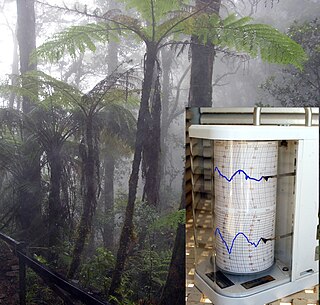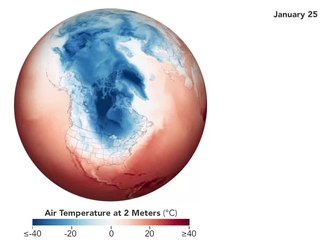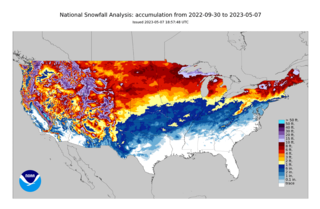Weather is the state of the atmosphere, describing for example the degree to which it is hot or cold, wet or dry, calm or stormy, clear or cloudy. On Earth, most weather phenomena occur in the lowest layer of the planet's atmosphere, the troposphere, just below the stratosphere. Weather refers to day-to-day temperature, precipitation, and other atmospheric conditions, whereas climate is the term for the averaging of atmospheric conditions over longer periods of time. When used without qualification, "weather" is generally understood to mean the weather of Earth.

The heat index (HI) is an index that combines air temperature and relative humidity, in shaded areas, to posit a human-perceived equivalent temperature, as how hot it would feel if the humidity were some other value in the shade. For example, when the temperature is 32 °C (90 °F) with 70% relative humidity, the heat index is 41 °C (106 °F). The heat index is meant to describe experienced temperatures in the shade, but it does not take into account heating from direct sunlight, physical activity or cooling from wind.

Wind chill is the sensation of cold produced by the wind for a given ambient air temperature on exposed skin as the air motion accelerates the rate of heat transfer from the body to the surrounding atmosphere. Its values are always lower than the air temperature in the range where the formula is valid. When the apparent temperature is higher than the air temperature, the heat index is used instead.
A cease and desist letter is a document sent by one party, often a business, to warn another party that they believe the other party is committing an unlawful act, such as copyright infringement, and that they will take legal action if the other party continues the alleged unlawful activity. The letter may warn that, if the recipient does not discontinue specified conduct, or take certain actions, by deadlines set in the letter, the letter's recipient may be sued. The phrase "cease and desist" is a legal doublet, made up of two near-synonyms. A cease and desist letter issued by a government entity, called a cease and desist order, is "a warning of impending judicial enforcement".
Lumen, formerly Chilling Effects, is an American collaborative archive created by Wendy Seltzer and operated by the Berkman Klein Center for Internet & Society at Harvard University. It allows recipients of cease-and-desist notices to submit them to the site and receive information about their legal rights and responsibilities.
In a legal context, a chilling effect is the inhibition or discouragement of the legitimate exercise of natural and legal rights by the threat of legal sanction. A chilling effect may be caused by legal actions such as the passing of a law, the decision of a court, or the threat of a lawsuit; any legal action that would cause people to hesitate to exercise a legitimate right for fear of legal repercussions. When that fear is brought about by the threat of a libel lawsuit, it is called libel chill. A lawsuit initiated specifically for the purpose of creating a chilling effect may be called a strategic lawsuit against public participation (SLAPP).

The climate of Chicago is classified as hot-summer humid continental with hot humid summers and cold, occasionally snowy winters. All four seasons are distinctly represented: Winters are cold and often see snow with below 0 Celsius temperatures and windchills, while summers are warm and humid with temperatures being hotter inland, spring and fall bring bouts of both cool and warm weather and fairly sunny skies. Annual precipitation in Chicago is moderate and relatively evenly distributed, the driest months being January and February and the wettest July and August. Chicago's weather is influenced during all four seasons by the nearby presence of Lake Michigan.

A windbreaker, or a windcheater, is a thin fabric jacket designed to resist wind chill and light rain, making it a lighter version of the jacket. It is usually of lightweight construction and characteristically made of a synthetic material. A windbreaker often uses elastic waistbands, and/or armbands, and a zipper to allow adjustments for the current weather conditions.
This article describes severe weather terminology used by the National Weather Service (NWS) in the United States. The NWS, a government agency operating as an arm of the National Oceanic and Atmospheric Administration (NOAA) branch of the United States Department of Commerce (DoC), defines precise meanings for nearly all of its weather terms.

Apparent temperature, also known as "feels like", is the temperature equivalent perceived by humans, caused by the combined effects of air temperature, relative humidity and wind speed. The measure is most commonly applied to the perceived outdoor temperature. Apparent temperature was invented by Robert Steadman who published a paper about it in 1984. However, it also applies to indoor temperatures, especially saunas, and when houses and workplaces are not sufficiently heated or cooled.
In weather forecasting in the United States, "particularly dangerous situation" (PDS) is enhanced wording used by the National Weather Service to convey special urgency in some watch or warning messages when there is a significant risk of extreme weather, most commonly from types of weather events that are usually less severe by comparison, such as a severe thunderstorm outbreak or flash flooding. It is used in the format "This is a particularly dangerous situation..." at the discretion of the issuing forecaster. A watch or warning bearing the phrase is referred to as a PDS watch or PDS warning as shorthand jargon.
The chilling requirement of a fruit is the minimum period of cold weather after which a fruit-bearing tree will blossom. It is often expressed in chill hours, which can be calculated in different ways, all of which essentially involve adding up the total amount of time in a winter spent at certain temperatures.
A Special Weather Statement is a form of weather advisory. Special Weather Statements are issued by the National Weather Service of the United States (NWS) and the Meteorological Service of Canada (MSC). There are no set criteria for special weather statements in either country.
A wind chill advisory is a hazardous weather statement issued by Weather Forecast Offices (WFO) of the National Weather Service (NWS) in the United States to alert the public that wind chills are forecast to reach values low enough that it poses a threat to human health and life if adequate protection is not taken against hypothermia and frostbite. The exact criteria meriting the issuance of an advisory varies from state to state, and areas prone to colder temperatures will often require the wind chill to be lower before issuing an advisory.
A wind chill watch is issued by the National Weather Service of the United States when the wind chill could reach dangerous levels within the next 12 to 48 hours. The exact definition required to issue a watch varies from state to state or from National Weather Service county warning areas to another, but if forecasters believe conditions are favorable for life-threatening wind chills meeting local criteria, a watch will be issued. People going outside should plan to protect themselves against hypothermia and frostbite.
A wind chill warning is a hazardous weather statement issued by local forecast offices of the National Weather Service (NWS) in the United States and previously by the Meteorological Service of Environment and Climate Change Canada (ECCC) when wind chills are forecast to reach values low enough for residents and travelers to be susceptible to life-threatening medical conditions or death associated with accelerated body heat loss.
An extreme cold warning is issued by Environment Canada to inform the public about active or imminent severe cold temperatures in their region that are expected to last for at least two hours.

In late January 2019, a severe cold wave caused by a weakened jet stream around the Arctic polar vortex hit the Midwestern United States and Eastern Canada, killing at least 22 people. It came after a winter storm brought up to 13 inches (33 cm) of snow in some regions from January 27–29, and brought the coldest temperatures in over 20 years to most locations in the affected region, including some all-time record lows. In early February, a concentration of Arctic air colloquially referred to as the "polar vortex" moved west, and became locked over Western Canada and the Western United States. As a result, February 2019 was among the coldest and snowiest on record in these regions. In early March, the cold once again shifted east, breaking records in many areas. In mid-March, the cold wave finally retreated, but combined with above-average temperatures, precipitation, and a deep snowpack, widespread flooding ensued in the Central US.

The southeast Australian foehn is a westerly foehn wind and a rain shadow effect that usually occurs on the coastal plain of southern New South Wales, and as well as in southeastern Victoria and eastern Tasmania, on the leeward side of the Great Dividing Range. Ranging from cool to hot, the effect occurs when westerly winds descend steeply from the Great Dividing Range onto the coastal slopes, whereby causing major adiabatic compression and a substantial loss of moisture.

The 2022–23 North American winter was an unusually warm winter for the east and an unusually cold winter for the west in North America, as it occurred across the continent from late 2022 to early 2023. The winter season in North America began at the winter solstice, which occurred on December 21, 2022, and it ended at the March equinox, which occurred on March 20, 2023. The first day of meteorological winter began on December 1 and unofficially ended on February 28; winter storms may still occur outside of these limits.







